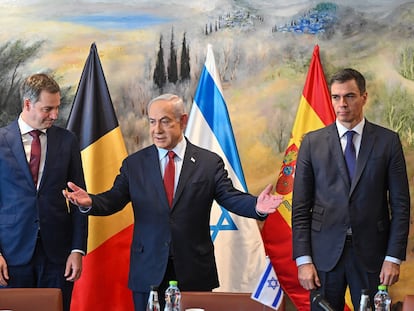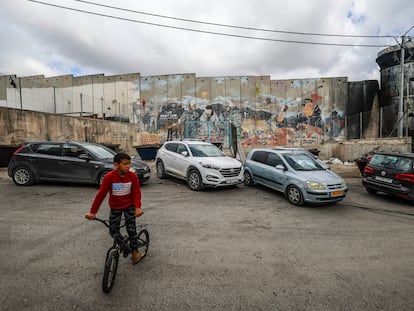A day without bombs in Gaza: ‘We’re enjoying the smell of freedom for the first time in almost 50 days’
Residents of the Strip take advantage of the beginning of the truce to look for food and try to find out if their loved ones are still alive
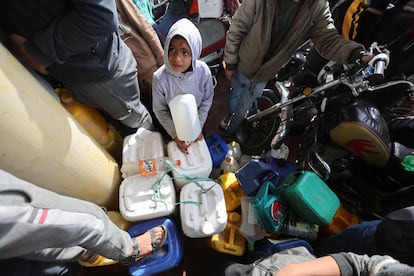
“We are enjoying the smell of freedom for the first time in almost 50 days,” says Karim, a resident of Rafah, in the south of the Gaza Strip, where on Friday — the first of four days of truce between Hamas and Israel — no explosions or gunshots could be heard. The scene he describes over the phone is that of thousands of people taking to the streets with the peace of mind that they are not going to be bombed. “They are walking like birds that are learning to fly without fear. The first thing on many minds is to visit or confirm the status of family and friends. Me, it’s the first thing I’ve done at the start of the day [...]. “How wonderful to feel free!” says Karim, an NGO employee who prefers, for security reasons, not to disclose any more personal information.
It has been 49 days since Israel began bombing Gaza in response to the Hamas attack on October 7, which killed about 1,200 people. Since then, Karim says, Gazans, especially children, have lived “indescribable moments, hearing bombs, gunshots… Nobody felt safe. We all thought we could be the next target and today we are enjoying this moment, happy for this temporary truce. Anything is good for us, even if it is going to the store to stock up, although there are hardly any things left to buy,” he adds. Of the 2.3 million inhabitants who are crammed into this small Palestinian territory of 141 square miles (365 km2), more than 14,800 are not alive today to enjoy this pause in the war, according to figures from local Hamas authorities.
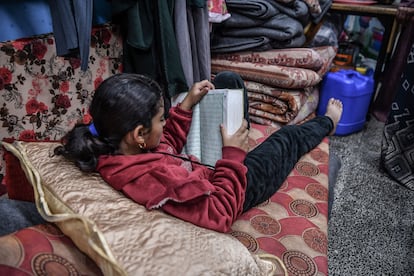
Karim is aware that this ceasefire is just a temporary parenthesis in the hostilities. This much has been reiterated by the Prime Minister of Israel, Benjamin Netanyahu, who said that there will be no permanent ceasefire. But for the moment Karim is content with going out into the streets without the fear of bombs. “I used to ride my bicycle feeling constantly afraid. “We didn’t go out on the street after 6 p.m., it was very dangerous, but now people can do whatever they want, at least during these four days of truce.” With renewed optimism, he talks about his dream of traveling to Barcelona to watch a soccer match.
Israel and Hamas have agreed on the possibility of adding one more day to the pause for every 10 additional hostages that are freed from Gaza, in addition to the 50 that are expected to be returned to Israel in these four days in exchange for the freedom of 150 Palestinians in Israeli prisons.
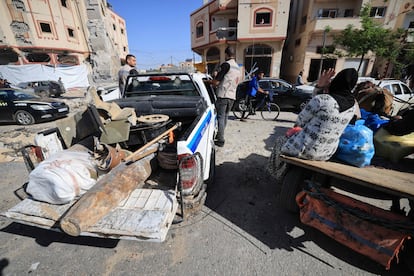
There is a sense of calm in Rafah, but residents are keeping an eye on what is happening a few miles further north. Several people who were trying to return to their homes in the north of the Strip were shot this Thursday by Israeli soldiers near the checkpoint that Israel has located in the center of the Strip, and which divides the territory into two halves, according to a telephone report by the Gazan journalist Mahmoud Assad. Israel has warned that the north, where the population was ordered to leave on October 12, is a “war zone” and access is off limits. The Israeli military only allows movement from north to south, to the so-called “safe zone,” where, however, until this Friday the bombings had not stopped.
Flour and bread
Doaa Ulyan, 33, is one of the 1.7 million Gazans taking refuge in the southern region of the Palestinian enclave. She is there with her children, ages eight and 10, and her husband. They tried to find protection in a shelter in the town of Khan Yunis and feel that, “finally,” they will be able to “rest a little” after so many days and, above all, so many nightmarish nights. “My husband has gone to the UN center to get flour so he can make bread for my children,” she explains. If the truce “continues,” she says, her husband will try to “get winter clothes for the kids, since it’s starting to get colder.”
However short-lived it may be, this temporary ceasefire is a respite for Gazans. Some have even gone to the beach to walk on the sand or bathe in the sea, according to images shared on social media. That relief is especially important for the little ones. At least 6,150 minors, according to data from the local Hamas government, have died in the war. “My children are very, very happy,” says Ulyan. The children “think the war is over and have asked me when we can go home. We have not yet told them that we no longer have a home to return to,” she says. The woman explained to them that the truce will only last four days. “We have told them to pray so that it is definitive.”
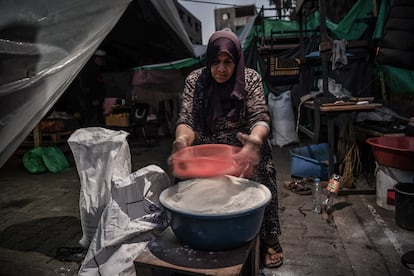
Azmi Keshawi, who was also displaced with his family from the capital to Khan Yunis, says that he no longer has “anywhere to return to in the north,” but that this truce will allow many Gazans to “find out what is happening” with their families. “From a distance and with communications cut off, it is almost impossible,” he says. The pause in the war, he assures, not only allows them to go out without fear to search for food. They can also lend money to each other to survive, which has ended up becoming important in the south because food is scarce. “There are very few things and they are very expensive,” he adds.
Gazans “lack everything,” confirms Jalil Abu Shammaleh, former director of the NGO Addameer, from the same city. This 53-year-old humanitarian worker does not trust the Israelis, “who could break the truce at any moment.” Nor is he confident that the uptick in humanitarian aid during the four days, included in the agreement between Israel and Hamas, will be enough to cover “the enormous needs” that 48 days of bombing have left behind. Between October 21 and November 23, the day before the start of the pause, only 1,723 trucks with basic supplies entered Gaza through the Egyptian border. Before the day of the Hamas attack and the start of hostilities, an average of 10,000 trucks had entered monthly with humanitarian aid and basic goods.
Trucks with supplies are already entering through the border crossing with Egypt in Rafah. Egypt has said the convoy will carry, among other goods, 130,000 liters of diesel per day and four trucks of cooking gas. Basic humanitarian operations alone, such as aid delivery, require 150,000 liters of fuel per day, according to the UN Refugee Agency (UNRWA). In total, 137 trucks with aid entered Gaza this Friday.
Sign up for our weekly newsletter to get more English-language news coverage from EL PAÍS USA Edition
Tu suscripción se está usando en otro dispositivo
¿Quieres añadir otro usuario a tu suscripción?
Si continúas leyendo en este dispositivo, no se podrá leer en el otro.
FlechaTu suscripción se está usando en otro dispositivo y solo puedes acceder a EL PAÍS desde un dispositivo a la vez.
Si quieres compartir tu cuenta, cambia tu suscripción a la modalidad Premium, así podrás añadir otro usuario. Cada uno accederá con su propia cuenta de email, lo que os permitirá personalizar vuestra experiencia en EL PAÍS.
¿Tienes una suscripción de empresa? Accede aquí para contratar más cuentas.
En el caso de no saber quién está usando tu cuenta, te recomendamos cambiar tu contraseña aquí.
Si decides continuar compartiendo tu cuenta, este mensaje se mostrará en tu dispositivo y en el de la otra persona que está usando tu cuenta de forma indefinida, afectando a tu experiencia de lectura. Puedes consultar aquí los términos y condiciones de la suscripción digital.
More information
Archived In
Últimas noticias
Most viewed
- Sinaloa Cartel war is taking its toll on Los Chapitos
- Oona Chaplin: ‘I told James Cameron that I was living in a treehouse and starting a permaculture project with a friend’
- Reinhard Genzel, Nobel laureate in physics: ‘One-minute videos will never give you the truth’
- Why the price of coffee has skyrocketed: from Brazilian plantations to specialty coffee houses
- Silver prices are going crazy: This is what’s fueling the rally
